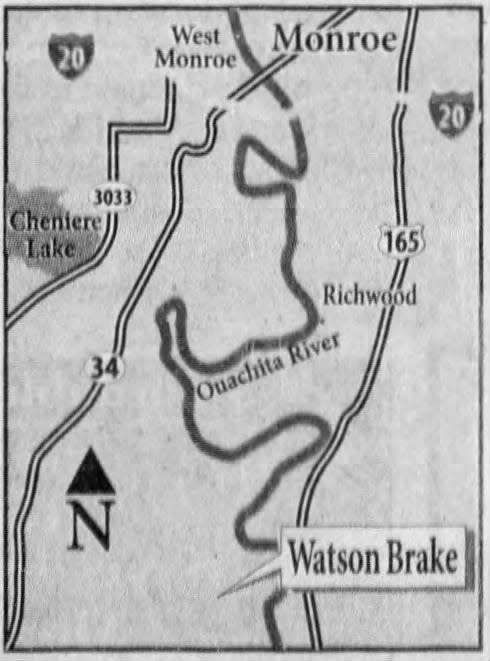This Louisiana archaeological site predates Stonehenge and the pyramids: check out its history
Ouachita Parish is full of history including a prehistoric landmark that is nearly 5,400 years old.
Watson Brake, located south of Monroe on the edge of an alluvial terrace overlooking an archaeological site, is home to 11 earthen bounds connected by ridges. It is considered among the oldest and most preserved earthworks from the Archaic period, pre-dating the Ancient Egyptian pyramids and Stonehenge.
The site was built by a hunter-gatherer society, known as the Evans culture, around 3500 BCE. Diana Greenlee, station archaeologist and adjunct professor at the University of Louisiana Monroe School of Sciences, said the site is significant because of its creators.
More: What is Poverty Point? Ancient history discovered in real time in West Carroll Parish
"Watson Brake is really significant because it's one of those really complex earthwork sites that was built by hunter-gatherers," Greenlee said. "For a long time, archaeologists didn't think that hunter-gatherers could do that they would be so organized and so complex with the work they created."
Imagine the people who are living by hunting, fishing and gathering wild resources, coming together to build the amazing complex of earthworks, Greenlee said.
"What's really cool too is that it's not the only one," Greenlee said. "There are other earthwork complexes around but it's one that has, the most sort of complex design. It's the oldest complex of mounds in the US as well."

The two curved ridges links groups of earthworks that are referred to as the north and south mounds. Together, the two features form a large enclosure measuring 984 by 656 feet.
There are approximately 12 mounds, with the largest being Mound A, erected at 25 feet tall with a basal diameter of 230 feet tall. The second largest mound, Mound E, stands at 13 feet tall. The other nine mounds range between 1.6 to 11 feet.
The construction of the mounds took place over six hundred to seven hundred years, from 3500 BCE to sometime after 2800 BCE.
The site was discovered by avocational archaeologist Reca Jones during the early 1980s. Regional archaeologist Joe Saunders was also shown the site. With the help from Harvard graduate student John Belmont, Jones sketched the first map of the earthworks, which at the time, was considered a Poverty Point culture site. It wasn't until the 1990s that Watson Brake and 12 other Middle Archaic mound sites in the state were recognized.
More: ULM archaeologist: Poverty Point World Heritage Site more complex than previously thought
Jones and Saunders were published in The "New York Times" and "Science Magazine" on September 9, 1997 for the discovery of Watson Brake. Jones worked tirelessly to have the area declared a state park to preserve its artifacts.
The artifacts on the site, many of which Greenlee described as "really amazing," were made from locally available resources. A distinctive and characteristic
"The creation of stone beads and these geometric shaped objects that are made out of the local dirt," Greenlee said. "Watson Brake is pretty amazing in its complexity and some people would consider, precocious even."

Inhabitants at Watson Brake were the first some of the first in Louisiana to make stone beads from local chert gravel. The gravel was flaked to about half an inch long, and then laboriously ground smooth, presumably with sand and water. Holes for stringing the beads were created using tiny stone “microdrills,” made from stone flakes or blades. To drill completely through a bead, the drill must have been hafted onto a wooden or bone shaft.
Other artifacts include fire-earthen blocks, many of which are about 1.5 inches square cubes. Bone tools were scarce, but included eight awls and a fishhook, along with one finished and five unfinished beads.
An antler flaker, used for fine edge sharpening on stone tools, is the only antler artifact. The artifacts were found at the base of Mound B, where a shell deposit may have added to the pH of the soil, aiding in bone preservation.
More: ULM archaeologist: Poverty Point World Heritage Site more complex that previously thought
The southern half of the site was owned by the Archaeological Conservatory, which later sold it to the state for preservation. The Gentry family has owned most of the site since the 1950s and has also declined to sell their half of the property to the state, so the site is not available for public viewing.
However, the family has granted specific permission to individual archaeologists to conduct research on-site.
Follow Ian Robinson on Twitter @_irobinson and on Facebook at https://bit.ly/3vln0w1.
Support local journalism by subscribing at https://cm.thenewsstar.com/specialoffer.
This article originally appeared on Monroe News-Star: Ouachita Parish archaeological site dates back to 3500 BCE
